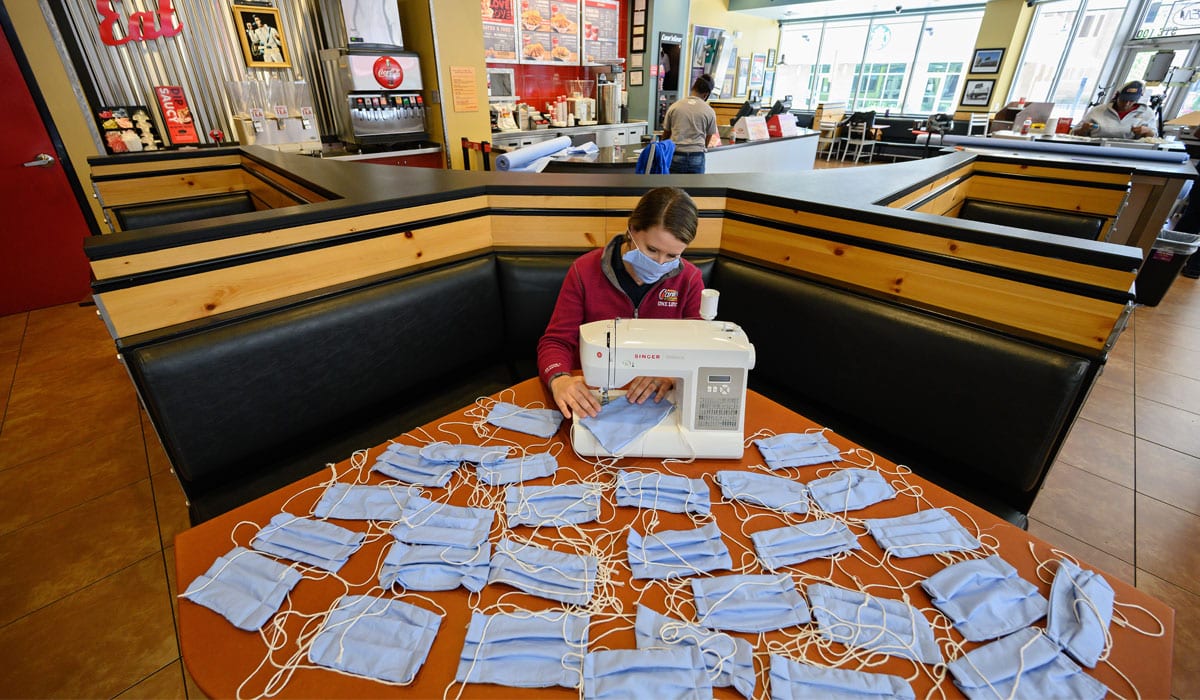Co-CEO AJ Kumaran is quite proud that Raising Cane’s opened 69 restaurants in 2021.
But what he’s just as excited about—if not more—is that the fast casual created 8,000 jobs in the final four months of the year.
He’s reminded of a recent opening in Salt Lake City, Utah, where below freezing temperatures didn’t prevent more than 200 customers from waiting in line overnight until Raising Cane’s made its official debut at 11 a.m. Kumaran credits the store-level employees for making it a success.
“Our crew members show a lot of passion to what they do in our business and that translates to customer loyalty who see what our crew members do,” Kumaran says. “ … We are able to do some beautiful things for people and that’s what we do this for. We are a team together, and we are not gouging profits. We are a business with a lot of heart and soul.”
The chain’s nearly 70 openings last year was a noticeable improvement from 2020, when 52 restaurants came online—trailing only Wingstop, Popeyes, and Chick-fil-A in the chicken segment, according to QSR 50 data.
In 2022, Raising Cane’s is pushing the bar even higher with 100 anticipated openings, including the recent debut of its 600th restaurant in Corona, California. To support that growth, the company plans to hire more than 15,000 workers throughout the year.
Team building has been a crucial part of Raising Cane’s methodical expansion strategy, Kumaran says. He attributes much of the recent success to a Restaurant Partner Program—launched around the start of the pandemic—that helps store managers become operators of company-owned restaurants.
Partners receive expertise in marketing, training, facilities, recruiting, and operations, health and financial planning support, and more than $100,000 in annual compensation, including salary, bonuses, and performance-based incentives. Raising Cane’s claims operators in the program have the chance to become millionaires in as quickly as 12 years.
When COVID arrived in March 2020, the company refused to furlough or lay off any of its 23,000 workers. A couple of months later, Raising Cane’s doubled down on its “No Crew Left Behind” mentality by distributing $2 million in bonuses to account for hours some employees gave up so everyone could remain employed. Neither Kumaran nor founder and co-CEO Todd Graves were taking a salary at the time.
Then in August, the fast casual bolstered retention efforts by expanding its educational benefits, including access to college-level courses, reimbursed class costs to complete a high school diploma, and up to $5,250 per year in tuition reimbursement.
Those are some of the reasons why Raising Cane’s was one of only three restaurant brands names to Forbes’ “Best Employers for New Grads” and one of only four hospitality companies to be on Glassdoor’s “100 Best Places to Work in the U.S.”
“We get the best talent in the industry to join us and be the restaurant leaders of our businesses,” Kumaran says.
The brand prides itself as being a company in which all employees, from hourly worker to CEO, have “fry cook and cashier” as part of their job description. That became more of a reality in the fall, when 50 percent of corporate staff entered restaurants across the country. They were charged with performing day-to-day tasks and recruiting enough employees to build the workforce from 40,000 to 50,000.
Within 48 days, Raising Cane’s exceeded its goal with 53,000 employees.
“Our application numbers and hire rates remain some of the highest we’ve ever seen in the business, and we continue to add to our crew member base. It has been a very big success. More than numbers, honestly, it brought teams very, very closely together,” Kumaran says. “We’re all fry cooks and cashiers. That’s has always been our approach and to really show to the world that we are all fry cooks and cashiers. We’re all doing it for the same reason. That was powerful.”



“We are about giving out craveable chicken finger meals to every customer who walks in through our front door, also the drive-thru, and spends their hard-earned money with us,” Raising Caine’s co-CEO AJ Kumaran says. “That’s what we’re all about and that’s what we’re good at and that’s what we will continue doing.”
Thanks in large part to those crew members, the company is seeing more than $5 million in AUV, one of the highest in the quick-service industry for a chain its size.
Raising Cane’s has constructed a pipeline of more than 300 restaurants over the past three to four years, most of which are freestanding drive-thru locations. More than 80 percent of units are company-owned, and that will remain as the primary growth vehicle.
“We are not a franchise business. We are a company-owned-and-operated model,” Kumaran says. “That allows us to be nimble, flexible, and do all the right things, such as investing in people. We have a slate of multi-restaurant leaders all across these new markets who don’t even have restaurants yet, but they’re just getting their pencils sharpened and their training sharpened up to get going.”
Units coming this year will be some of the most ambitious yet. For example, Raising Cane’s plans to open an 8,500-square-foot flagship in New York City, which will be the largest restaurant in Times Square and will “showcase to the world our passion for chicken finger meals and our history,” according to Kumaran.
Additionally, a West Coast flagship will open as one of the largest quick-service outlets on the Las Vegas Strip, right next to MGM Grand Hotel & Casino. The outlet will “speak to the history and the culture of Vegas city in a Cane’s manner.” Another flagship in Miami will be housed in an art deco building.
Other target markets include Boston, Nashville, Philadelphia, the DMV, and New Jersey. Raising Cane’s announced that it will enter 10 new markets this year; Kumaran says that will likely reach 12-15 markets over the next 15 months.
“Our growth model is to be a global footprint, but have a very local presence and identity,” Kumaran says.
The fast casual’s growth journey won’t be without challenges, however. Because of a variety of macroeconomic factors, Kumaran estimates the brand pushed about 10 of its openings from 2021 into this year. He knows there will be more concerns in 2022, but the executive adds that Raising Cane’s is in a solid position because of its strong, mutual relationship with suppliers.
Kumaran says supply chain, construction, and staffing challenges are “not only unprecedented, but they are very, very hard.” That’s why Raising Cane’s plans to leverage its more than 25 years of legacy and consistency to maintain growth and its position as a preferred place of employment.
“We are about giving out craveable chicken finger meals to every customer who walks in through our front door, also the drive-thru, and spends their hard-earned money with us,” Kumaran says. “That’s what we’re all about and that’s what we’re good at and that’s what we will continue doing. I have very high expectations out of 2022 coming up here and I honestly have even higher expectations of the future. I think we’re just getting warmed up. I think we will have thousands and thousands of restaurants all across the world.”






